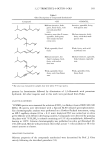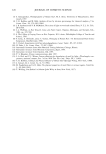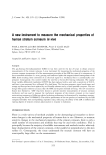Table II Loss (%) in Wet Mechanical Properties of Hair Exposed at Various RH Block A Work-to-20%-extension Time/RH 10 20 30 50 70 100 h 26.98 12.56 11.16 17.67 22.79 200 h 38.60 28.84 18.60 22.79 32.09 300 h 46.98 29.30 34.42 25.12 46.51 Stress-at-20%-strain Time/RH 10 20 30 50 70 100 h 22.73 11.36 11.36 13.64 20.45 200 h 38.64 27.27 18.18 18.18 29.55 300 h 47.73 27.27 31.82 22.73 43.18 Block B Initial modulus Time/RH 10 20 30 50 70 100 h 23.62 9.77 12.38 11.31 21.85 200 h 35.23 25.38 33.38 14.54 35.85 300 h 43.31 21.85 26.23 32.23 46.69 Post-yield modulus Time/RH 10 20 30 50 70 100 h 17.42 9.76 42.51 17.77 39.37 200 h 24.04 20.91 50.52 12.89 55.05 300 h 32.06 25.78 47.39 35.54 60.63 Work-to-break Time/RH 10 20 30 50 70 100 h 15.26 13.88 -2.02 19.02 19.09 200 h 31.02 29.21 4.05 13.81 7.66 300 h 41.43 24.15 11.71 13.88 23.14 Stress-to-break Time/RH 10 20 30 50 70 100 h 25.79 19.50 27.67 25.79 33.33 200 h 34.59 32.08 32.08 20.75 44.03 300 h 44.65 29.56 35.85 32.70 49.06 B•& C Turnover point Time/RH 10 20 30 50 70 100 h -11.44 -4.40 -24.04 -5.28 -27.74 200 h -9.94 -4.56 -24.66 -10.07 -40.51 300 h -9.33 -9.12 -21.92 -13.40 -36.54 Strain-to-break Time/RH 10 20 30 50 70 100 h -11.28 -3.86 -23.23 -4.10 -28.49 200 h -10.59 -4.11 -22.82 -9.42 -41.67 300 h -10.67 -8.14 -31.24 -14.08 -43.14
316 JOURNAL OF COSMETIC SCIENCE 5O e 30 • 2O 10 0 i • i 100 hours 200 hours 300 hours 0 20 40 60 80 % RH Figure 4. Reduction in work-to-20%-strain of Piedmont hair exposed to simulated solar radiation. 50 ß 40 • 30 ß • 2O 10 ß 100 hours ß 200 hours ß 300 hours 0 20 40 60 80 % RH Figure 5. Reduction in stress-at-20%-strain of Piedmont hair exposed to simulated solar radiation. ANALYSIS OF THE FTIR SPECTRUM The FTIR/ATR spectra obtained from Piedmont hair exposed for 300 hours at different RH levels are shown in Figure 7. The spectra were normalized using the absorbance at 1513 cm -1 (peak 1), the amide-II band, allowing a semiquantitative comparison of the cystine oxide content. A listing of the different absorbance peaks is given in Table III (2). The absorbances at 1042 cm 1 (peak 5) due to cysteic acid and at 1073 cm -• (peak 4) due to cystine monoxide, the primary degradation products of the disulfide links, indicate that irradiation at 20% RH caused the least amount of degradation. These absorbances for fibers exposed to radiation at other RH levels are essentially invariant, as shown in Figure 7. Since the beam essentially penetrated only the cuticle, the results suggest that damage to the cuticle is nearly identical for irradiation under different conditions over similar duration of exposure. This concurs with the results reported by Hoting eta/. (2). The low absorbances shown for exposure at 20% RH are probably due to experimental error. An important point to be noted is that cuticular damage, unless excessive, does not affect the tensile properties significantly (16). However, such damage is often the cause of crack initiation and fiber fracture. ROLE OF MOISTURE IN HAIR PHOTOLYSIS According to Arnaud (17), photolysis of hair proteins is caused by radiation with
Purchased for the exclusive use of nofirst nolast (unknown) From: SCC Media Library & Resource Center (library.scconline.org)

























































